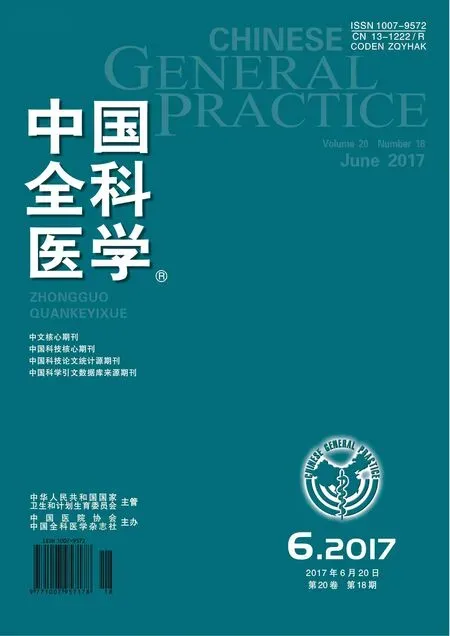老年认知功能障碍与运动功能的相关性研究
李淑娟,刘 倩,李言洵,蒋晓燕,王笑峰,胡志灏,胡文立*
·论著·
老年认知功能障碍与运动功能的相关性研究
李淑娟1,刘 倩1,李言洵1,蒋晓燕2,王笑峰3,胡志灏1,胡文立1*
背景 老年人的认知功能和躯体运动功能均会有不同程度的减退,老年人认知功能与简单的运动功能的相关性鲜见报道。目的 探讨老年认知功能障碍(CI)与运动功能的相关性。方法 2014-11-13至2014-12-21从如皋市江安镇招募了1 788例年龄为70~84岁的老年人。根据改良长谷川痴呆量表(HDS-R)评分分为正常组(≥31.0分)、边缘状态组(22.0~30.5分)、可疑痴呆组(10.5~21.5分)、痴呆组(≤10.0分),采用起立-行走计时测试检测老年人运动功能,记录测试时间、步态稳定性及摔倒危险性评分。结果 共1 655例老年人完成HDS-R及起立-行走计时测试,其中正常组109例、边缘状态组674例、可疑痴呆组833例、痴呆组39例。正常组测试时间短于边缘状态组、可疑痴呆组、痴呆组,步态稳定率高于可疑痴呆组、痴呆组,摔倒危险性评分低于可疑痴呆组、痴呆组(P<0.05);边缘状态组测试时间短于可疑痴呆组、痴呆组,步态稳定率高于可疑痴呆组、痴呆组,摔倒危险性评分低于可疑痴呆组、痴呆组(P<0.05);可疑痴呆组测试时间短于痴呆组,摔倒危险性评分低于痴呆组(P<0.05)。HDS-R评分与起立-行走计时测试的测试时间、步态稳定率和摔倒危险性评分呈负相关(相关系数分别为-0.243、-0.120和-0.163,P<0.001)。结论 老年人认知功能和躯体运动功能减退,随着步态不稳定以及摔倒危险性的增加,CI的风险明显增加。
认知障碍;运动障碍;运动试验;老年人
李淑娟,刘倩,李言洵,等.老年认知功能障碍与运动功能的相关性研究[J].中国全科医学,2017,20(18):2193-2196.[www.chinagp.net]
LI S J,LIU Q,LI Y X,et al.Correlation between cognitive impairment and motor function in the elderly[J].Chinese General Practice,2017,20(18):2193-2196.
随着我国人口老龄化进程的不断加速,认知功能障碍(CI)及痴呆患者的数量也不断增加,我国痴呆患者超过5%,约占全世界患者总数的1/4,且每年约30万人发生痴呆[1]。而近期有研究报道老年CI者运动功能减退[2-4],有CI者运动功能比无CI者更差[5]。 BURACCHIO等[6]在一项长达20年的研究中发现,步行、拍手速度等运动功能与认知功能下降密切相关,步行速度的下降甚至可预测CI的发生。近期的系统综述也支持步行异常提示CI的发生[7]。
起立-行走计时(TUG)测试是近20余年来临床广泛使用的简单、快速评价运动功能的方法之一[8]。其仅需极少量设备,测试了包括从坐到站立及从站立到坐下的转身、直线行走、平衡控制等运动功能[9]。TUG测试及其衍生出来的多种测试在致残性疾病、老年人摔倒风险、CI运动功能评价等中得到了广泛认可[9-12]。
随着年龄增长,老年人的认知功能和躯体运动功能均会有不同程度的减退[13],本研究试图探索老年人认知功能与简单的运动功能的关系,以期加深对CI患者合并运动功能异常的认识,为防止CI老年人群摔倒致残及通过运动锻炼延缓CI进展提供借鉴。
1 资料与方法
1.1 纳入与排除标准 纳入标准:(1)年龄70~84岁;(2)可以独自或借助工具移动、转身完成TUG测试;(3)能够配合完成改良长谷川痴呆量表(HDS-R);(4)签署知情同意书。排除标准:(1)下肢创伤史造成的行走障碍;(2)重度心肺疾病造成的活动受限;(3)有听力或表达障碍的患者。
1.2 一般资料 2014-11-13至2014-12-21从如皋市江安镇招募了1 788例年龄为70~84岁的老年人。均由经统一培训的医务人员进行问卷调查及体格检查,抽取晨起空腹血检测血糖、血脂等常规生化指标。本研究由复旦大学生命科学学院为牵头单位完成,通过了复旦大学伦理委员会审查。
1.3 认知功能评价 认知功能评价采用HDS-R[14-15],对该人群的定向力、记忆力、近记忆力、计算力及常识这5个方面进行评价,总分32.5分。根据HDS-R评分将老年人分为正常组(≥31.0分)、边缘状态组(22.0~30.5分)、可疑痴呆组(10.5~21.5分)、痴呆组(≤10.0分)。
1.4 运动功能评价 采用TUG测试[9]评价老年人的运动功能。准备一张有扶手的靠背椅和一个秒表,主要评价患者的躯体运动功能。评定时患者着平常穿的鞋,坐在有扶手的靠背椅上(椅子座高约45 cm,扶手高约20 cm),身体靠在椅背上,双手放在扶手上。如果使用助行具(如手杖、助行架),则将助行具握在手中。在离座椅3 m远的地面上贴一条可见的粗线。测试者发出“开始”的指令后,患者从靠背椅上站起。站稳后,按照平时走路的步态,向前走3 m,过粗线后转身,然后走回到椅子前,再转身坐下,靠到椅背上。测试过程中不能给予任何躯体的帮助。正式测试前,允许患者练习1~2次,以确保患者理解整个测试过程。测试者记录患者背部离开椅背到再次坐下(靠到椅背)所用的时间(测试时间)、步态稳定性(是、否)以及在完成测试过程中摔倒危险性评分(1分:正常;2分:轻微异常;3分:轻度异常;4分:中度异常;5分:重度异常)。

2 结果
2.1 不同认知功能组运动功能比较 共1 655例老年人完成HDS-R及TUG测试,其中正常组109例、边缘状态组674例、可疑痴呆组833例、痴呆组39例。不同认知功能组的测试时间、步态稳定率和摔倒危险性评分比较,差异有统计学意义(P<0.05)。正常组测试时间短于边缘状态组、可疑痴呆组、痴呆组,步态稳定率高于可疑痴呆组、痴呆组,摔倒危险性评分低于可疑痴呆组、痴呆组,差异有统计学意义(P<0.05);边缘状态组测试时间短于可疑痴呆组、痴呆组,步态稳定率高于可疑痴呆组、痴呆组,摔倒危险性评分低于可疑痴呆组、痴呆组,差异有统计学意义(P<0.05);可疑痴呆组测试时间短于痴呆组,摔倒危险性评分低于痴呆组,差异有统计学意义(P<0.05,见表1)。

表1 不同认知功能组运动功能比较
注:a为χ2值;与正常组比较,bP<0.05;与边缘状态组比较,cP<0.05;与可疑痴呆组比较,dP<0.05
2.2 CI与运动功能的相关性 HDS-R评分与TUG测试的测试时间、步态稳定性和摔倒危险性评分呈负相关(相关系数分别为-0.243、-0.120和-0.163,P<0.001)。
3 讨论
江苏省如皋市是我国著名的长寿之乡,在全国第1~5次人口普查中,如皋市老年人在总人口中的比例明显高于全国水平,因此本研究选取该地人群开展如皋市衰老队列基线调查以期更好地探讨老年人的病理生理特点。随着我国人口老龄化进程的不断加速,CI及痴呆患者不断增加,给家庭及社会带来沉重的经济负担[16]。研究发现部分CI患者尽管有一定的日常生活能力,但仍伴有躯体运动功能下降,这不但增加摔倒风险、加速认知功能下降,而且增加了家庭及社会对CI患者照看的难度[17]。本研究通过在如皋市开展的以人群为基础的横断面研究,发现在不同认知功能组间TUG测试的测试时间、步态稳定率及摔倒危险性评分均有显著差异,随着CI的加重,测试时间延长,步态稳定性变差且摔倒危险度增加。
3.1 随着CI加重移动功能变缓慢 本研究发现随着CI进展,TUG测试时间更长,提示CI者日常移动功能更差,且随着CI的加重移动功能逐渐减退。TUG测试时间包括了站立和坐下之间的转换、转身、直线行走所耗时间[11-12],其时间的延长可能与其中某一过程或多个过程相关。有研究定量分析了TUG测试不同过程,发现尽管两组个体总时间差异无统计学意义,但CI者站立和坐下之间的转换时间延长、转身时间延长及步行速变度慢导致行走时间延长[18]。
3.2 随着CI加重步态稳定性更差 本研究中随着CI进展,步态稳定率逐步降低,提示CI者有明显的步态变化,这与之前国外的报道一致[19]。虽然本研究只是定性判断步态情况,但与ALLALI等[4]及LIN等[20]研究对步态情况进行精确定量后分析得出的结果一致,这有助于老年照料者通过观察患者日常步态改变意识到潜在CI的发生。
3.3 随着CI加重摔倒危险性增加 TUG测试的摔倒危险性评分是人为对整个测试中测试者平衡异常程度的定性评价,主要反映了躯体基本运动功能中的移动功能[9]。有关CI者的平衡控制能力受损及摔倒风险增加已有报道[17,21],但相关机制尚不明确。有研究结合头部影像发现全脑萎缩是CI者躯体移动功能下降的危险因素[22],提示全脑退化可能是导致CI及躯体控制功能下降的因素。年龄相关脑白质疏松[23]及相关脑结构改变所致功能区纤维联系中断[24]与运动功能减退相关亦支持这一观点。同时研究表明躯体运动控制减退者与执行功能降低相关[21,25]。
3.4 本研究结果的适应条件 本研究表明CI老年人群躯体运动功能减退,对普通家庭及社区老年护理人员而言,照护CI患者需警惕躯体运动功能改变所致的潜在摔倒风险。
3.5 本研究局限性 (1)本研究样本量相对较小,仍需大规模、多中心社区调查研究来证实。(2)作为横断面研究不能明确认知功能与运动功能障碍发生先后及伴随改变关系,需行进一步前瞻性研究来明确。
综上所述,老年人认知功能和躯体运动功能减退,随着步态不稳定以及摔倒危险性的增加,CI的风险明显增加。这有利于社区医疗人员及时发现老年人CI及追踪病情变化,为将来临床治疗老年CI提供理论基础和诊疗依据。
作者贡献:李淑娟进行文章的构思与设计;李淑娟、蒋晓燕、王笑峰进行数据收集;李淑娟、刘倩、李言洵进行数据整理;李淑娟、刘倩、胡志灏进行统计学处理;李淑娟、刘倩撰写论文;胡文立对文章整体负责,监督管理。
本文无利益冲突。
[1]JIA J,WANG F,WEI C,et al.The prevalence of dementia in urban and rural areas of China[J].Alzheimers Dement,2014,10(1):1-9.DOI:10.1016/j.jalz.2013.01.012.
[2]WAITE L M,GRAYSON D A,PIGUET O,et al.Gait slowing as a predictor of incident dementia:6-year longitudinal data from the sydney older persons study[J].J Neurol Sci,2005,229/230:89-93.DOI:10.1016/j.jns.2004.11.009.
[3]郝立晓,贾建国,韩璎,等.主观认知下降社区管理研究现状[J].中国全科医学,2016,19(35):4285-4290.DOI:10.3969/j.issn.1007-9572.2016.35.001. HAO L X,JIA J G,HAN Y,et al.Community management status of subjective cognitive decline[J].Chinese General Practice,2016,19(35):4285-4290.DOI:10.3969/j.issn.1007-9572.2016.35.001.
[4]ALLALI G,LAUNAY C P,BLUMEN H M,et al.Falls,cognitive impairment,and gait performance:results from the GOOD initiative[J].J Am Med Dir Assoc,2017,18(4):335-340.DOI:10.1016/j.jamda.2016.10.008.
[5]SCHEPKER C A,LEVEILLE S G,PEDERSEN M M,et al.Effect of pain and mild cognitive impairment on mobility[J].J Am Geriatr Soc,2016,64(1):138-143.DOI:10.1111/jgs.13869.
[6]BURACCHIO T,DODGE H H,HOWIESON D,et al.The trajectory of gaitspeed preceding mild cognitive impairment[J].Arch Neurol,2010,67(8):980-986.DOI:10.1001/archneurol.2010.159.
[7]KIKKERT L H,VUILLERME N,VAN CAMPEN J P,et al.Walking ability to predict future cognitive decline in old adults:a scoping review[J].Ageing Res Rev,2016,27:1-14.DOI:10.1016/j.arr.2016.02.001.
[8]PODSIADLO D,RICHARDSON S.The timed "Up & Go":a test of basic functional mobility for frail elderly persons[J].J Am Geriatr Soc,1991,39(2):142-148.
[9]SPRINTG,COOK D J,WEEKSD L.Towards automating clinical assessments:a survey of the timed up and go(tug)"[J].IEEE Rev Biomed Eng,2015,8:64-77.DOI:10.1109/RBME.2015.2390646.
[11]KOJIMA G,MASUD T,KENDRICK D,et al.Does the timed up and go test predict future falls among British community-dwelling older people? Prospective cohort study nested within a randomised controlled trial[J].BMC Geriatr,2015,15:38.DOI:10.1186/s12877-015-0039-7.
[12]KOSE Y,IKENAGA M,YAMADA Y,et al.Timed Up and Go test,atrophy of medial temporal areas and cognitive functions in community-dwelling older adults with normal cognition and mild cognitive impairment[J].Exp Gerontol,2016,85:81-87.DOI:10.1016/j.exger.2016.09.019.
[13]TANG W K,WONG E,CHIU H F,et al.The Geriatric Depression Scale should be shortened:results of Rasch analysis[J].Int J Geriatr Psychiatry,2005,20(8):783-789.DOI:10.1002/gps.1360.
[14]NAKAMURA K,KITAMURA K,WATANABE Y,et al.Rural-urban differences in the prevalence of cognitive impairment in independent community-dwelling elderly residents of Ojiya city,Niigata Prefecture,Japan[J].Environ Health Prev Med,2016,21(6):422-429.DOI:10.1007/s12199-016-0542-2.
[15]ZHI T,WANG Q,LIU Z,et al.Body mass index,waist circumference and waist-hip ratio are associated with depressive symptoms in older Chinese women:results from the Rugao Longevity and Ageing Study(RuLAS)[J].Aging Ment Health,2017,21(5):1-6.DOI:10.1080/13607863.2015.1124837.
[16]SHAH H,ALBANESE E,DUGGAN C,et al.Research priorities to reduce the global burden of dementia by 2025[J].Lancet Neurol,2016,15(12):1285-1294.DOI:10.1016/S1474-4422(16)30235-6.
[17]BAHUREKSA L,NAJAFI B,SALEH A,et al.The impact of mild cognitive impairment on gait and balance:a systematic review and meta-analysis of studies using instrumented assessment[J].Gerontology,2017,63(1):67-83.DOI:10.1159/000445831.
[18]MIRELMAN A,WEISS A,BUCHMAN A S,et al.Association between performance on Timed Up and Go subtasksand mild cognitive impairment:further insights into the links between cognitive and motor function[J].J Am Geriatr Soc,2014,62(4):673-678.DOI:10.1111/jgs.12734.
[19]SCHERDER E,EGGERMONT L,SWAAB D,et al.Gait in ageing and associated dementias;its relationship with cognition[J].Neurosci Biobehav Rev,2007,31(4):485-497.DOI:10.1016/j.neubiorev.2006.11.007.
[20]LIN Y C,HSU W C,WU C K,et al.Comparison of motor performance of upper and lower extremities in dual-task tests in patients with mild Alzheimer′s dementia[J].Aging Clin Exp Res,2016,28(3):491-496.DOI:10.1007/s40520-015-0441-1.
[21]TANGEN G G,ENGEDAL K,BERGLAND A,et al.Relationships between balance and cognition in patients with subjective cognitive impairment,mild cognitive impairment,and Alzheimer disease[J].Phys Ther,2014,94(8):1123-1134.DOI:10.2522/ptj.20130298.
[22]YAMADA M,TAKECHI H,MORI S,et al.Global brain atrophy is associated with physical performance and the risk of falls in older adults with cognitive impairment[J].Geriatr Gerontol Int,2013,13(2):437-442.DOI:10.1111/j.1447-0594.2012.00927.x.
[23]ONEN F,HENRY-FEUGEAS M C,ROY C,et al.Mobility decline of unknown origin in mild cognitive impairment:an MRI-based clinical study of the pathogenesis[J].Brain Res,2008,1222:79-86.DOI:10.1016/j.brainres.2008.05.027.
[24]FUJIYAMA H,VAN SOOM J,RENS G,et al.Age-related changes in frontal network structural and functional connectivity in relation to bimanual movement control[J].J Neurosci,2016,36(6):1808-1822.DOI:10.1523/JNEUROSCI.3355-15.2016.
[25]MCGOUGH E L,KELLY V E,LOGSDON R G,et al.Associations between physical performance and executive function in older adults with mild cognitive impairment:gait speed and the timed "Up & Go" test[J].Phys Ther,2011,91(8):1198-1207.DOI:10.2522/ptj.20100372.
(本文编辑:崔莎)
Correlation between Cognitive Impairment and Motor Function in the Elderly
LIShu-juan1,LIUQian1,LIYan-xun1,JIANGXiao-yan2,WANGXiao-feng3,HUZhi-hao1,HUWen-li1*
1.DepartmentofNeurology,BeijingChao-YangHospital,CapitalMedicalUniversity,Beijing100020,China2.DepartmentofPathologyandPathophysiology,SchoolofMedicine,TongjiUniversity,Shanghai200092,China3.CollegeofLifeSciences,FudanUniversity,Shanghai200433,China
Background The cognitive and motor functions in the elderly decrease in different degree,but the relationship between them has been seldom reported.Objective To investigate the correlation between cognitive impairment(CI) and motor function in the elderly.Methods The participants were 1 788 70-84-year-old elderly people recruited from Jiang′an Town,Rugao City of China between November 13th and December 21st,2014.Based on the scores of Hasegawa′s Dementia Scale-Revised(HDS-R),they were divided into normal group(≥31.0),conditions between the normal and suspected dementia group(22.0-30.5),suspected dementia group(10.5-21.5) and dementia group(≤10.0).The body movement function of the elderly population was measured by timed up and go(TUG) test.The time needed to complete the TUG test,status of gait stability and the risk of falling were recorded.Results A total of 1 655 participants completed the assessment of cognitive function with the HDS-R,and TUG test,including 109 in the normal group,674 in conditions between the normal and suspected dementia group,833 in suspected dementia group and 39 in dementia group.Among the four groups,participants in the normal group used the least time to complete the TUG test,and they had the highest gait stability rate,and lowest risk of falling(P<0.05).Compared with the suspected dementia group and dementia group,conditions between the normal and suspected dementia group used less time to finish the TUG test,owned higher gait stability rate,and lower risk of falling(P<0.05).Suspected dementia group used less time to complete the TUG test,and owned lower risk of falling than the dementia group(P<0.05).The score of HDS-R presented a negative correlation with the time needed to complete the TUG test,with a correlation coefficient of-0.243,P<0.001.The score of HDS-R was negatively correlated with the status of gait stability with a correlation coefficient of-0.120,P<0.001.The score of HDS-R was negatively associated with the risk of falling with a correlation coefficient of-0.163,P<0.001.Conclusion The cognitive and the body movement function in the elderly are found to be decreased,and the risk of CI grows with the increase of gait instability and risk of falling.
Cognition disorders;Movement disorders;Exercise test;Aged
国家自然科学基金资助项目(81301015,81571372,81670465);北京市自然科学基金资助项目(7141001)
R 741
A
10.3969/j.issn.1007-9572.2017.18.005
2017-03-11;
2017-05-04)
1.100020 北京市,首都医科大学附属北京朝阳医院神经内科
2.200092 上海市,同济大学医学院病理学与病理生理学系
3.200433 上海市,复旦大学生命科学学院
*通信作者:胡文立,教授,主任医师;E-mail:2431965@qq.com
*Correspondingauthor:HUWen-li,Professor,Chiefphysician;E-mail:2431965@qq.com

